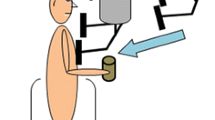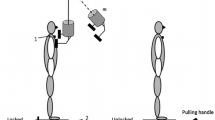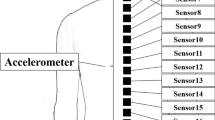Abstract
Eight normal human subjects were asked to maintain monopodal equilibrium on a narrow beam (task 1) or bipodal equilibrium on an unstable rocking platform (task 2) for 5 s. Each task was performed under four experimental conditions: (1) in light, (2) in darkness, (3) in light while subject had to hold a full cup of water, and (4) as in 3, but with additional instructions to fix the gaze on the cup. The movements of the trunk and head in the frontal plane were recorded by means of a 50-Hz TV image analyzer that computed the coordinates of small reflective markers glued on the skin of the subjects. On the beam the trunk was inclined on the side of the supporting foot (13 ± 9°), on the rocking platform the mean trunk orientation during the tests was nearly vertical (2 ± 7°). Nevertheless, in both tasks the mean head position was the same and close to vertical: 1.5 ± 4° on the rocking platform and 1.5 ± 5° on the beam. For both tasks and all experimental conditions the head remained stabilized relative to vertical, despite large translations in the frontal plane. Standard deviations of head orientation from its mean value were 2.8 ± 2° for task 1 and 2 ± 1.5° for task 2. The changes of trunk orientation were significantly higher: 6.2+4.8° and 4.5 ± 4°, respectively. The differences in angular stability of head and trunk, measured through the standard deviations of angular displacements, were especially pronounced in trials with large trunk movements. It was concluded that head angular stabilization, providing the central nervous system with necessary visual and vestibular references, is essential for effective dynamic postural control in the frontal plane during complex equilibrium tasks.
Similar content being viewed by others
References
Assaiante C, Amblard B (1990) Head stabilization in space while walking: effect of visual restriction in children and adults. In: Brandt T (ed) Xth International Symposium on Disorder of Posture and Gait. Verlag für Medizin, Munich, pp 229–233
Aubert H (1861) Eine scheinbare bedeutende Dehnung von Objekten bei Neigung des Kopfes nach rechts oder links. Virkows Arch 20: 381–393
Balliet R, Nakayama K (1978) Egocentric orientation is influenced by trained voluntary cyclorotary eye movements. Nature 21: 214–216
Berthoz A, Pozzo T (1988) Intermittent head stabilization during postural and locomotory tasks in humans. In: Amblard B, Berthoz A, Clarac F (eds) Development, adaptation and modulation of posture and gait. Elsevier, Amsterdam, pp 189–198
Brandt T, Paulus WM, Straub A (1985) Visual acuity, visual field and visual scene characteristics affect postural balance. In: Igarashi M, Owen Black F (eds) Vestibular and visual control on posture and locomotor equilibrium. Karger, Basel, pp 93–98
Clément G, Jacquin T, Berthoz A (1985) Habituation of postural readjustements induced by motion of visual scenes. In: Igarashi M, Owen Black F (eds) Vestibular and visual control on posture and locomotor equilibrium. Karger, Basel, pp 99–104
Collewijn H, Van der Steen J, Ferman L, Jansen TC (1985) Human ocular counterroll: assessment of static and dynamic properties from electromagnetic sceral coil recordings. Exp Brain Res 59: 185–196
Dichgans J, Held R, Young ER, Brandt T (1972) Moving visual scenes influence the apparent direction of gravity. Science 178: 1217–1219
Droulez J (1988) Topological aspects of sensori-motor control. In: Gurfinkel VS, Ioffe ME, Massion J, Roll JP (eds) Stance and motion, facts and concepts. Plenum, New York, pp 251–259
Droulez J, Berthoz A (1986) Servo-controlled (conservative) versus topological (projective) mode of sensory motor control. In: Bles W, Brandt T (eds) Disorders of posture and gait. Elsevier, Amsterdam, pp 83–97
Droulez J, Berthoz A, Vidal PP (1985) Use and limits of visual vestibular interaction in the control of posture. Are there two modes of sensorimotor control? In: Igarashi M, Owen Black F (eds) Vestibular and visual control on posture and locomotor equilibrium. Karger, Basel, pp 14–21
Fomin SV, Stillkind TI (1973) On the dynamic equilibrium of the pedatar system. In: Gydikov A, Tankov NT, Kosarov DS (eds) Motor control. Plenum, New York
Grossman GE, Leigh RJ, Abel LA, Lanska DJ, Thurston SE (1988) Frequency and velocity of rotational head perturbation during locomotion. Exp Brain Res 70: 470–476
Gurfinkel V, Levik Y (1991) Perceptual and automatic aspects of the postural body scheme. In: Paillard J (ed) Brain and space. Oxford University Press, New York, pp 147–162
Gurfinkel VS, Kots JM, Paltsev FI, Feldman AG (1971) Organization of interarticular interaction as exemplified by compensation of respiratory disturbances in the orthograde posture in man. In: Gelfand IM (ed) Models of the structural functional organization of certain biological systems. MIT Press, Cambridge, Mass, pp 382–395
Horak FB, Nashner LM (1986) Central programming of postural movements: adaptation to altered support-surface configurations. J Neurophysiol 55(6): 1369–1370
Hugon M, Massion J, Wiesandanger M (1982) Anticipatory postural changes induced by active unloading and comparison with passive unloading in man. Pflugers Arch 393: 292–296
Keshner EA, Cromwell R, Peterson B (1992) Head stabilization during vertical seated rotations and gait. In: Woollacott M, Horak F (eds) Posture and gait: control mechanisms. University of Oregon, Portland, pp 105–108
Marsden CD, Merton PA, Morton HP (1981) Human postural responses. Brain 104: 513–534
Mauritz KH, Dichgans J, Hufschmidt A (1977) The angle of vision roll motion determines displacement of subjective vertical. Percept Psychophys 22: 557–562
Mittelstaedt H (1983) A new solution to the problem of the subjective vertical. Naturwissenschaften 70: 272–281
Mouchnino L, Aurenty R, Massion J, Pedotti A (1990) Coordinated control of posture and equilibrium during leg movement. In: Brandt T (ed) Xth International Symposium on Disorder of Posture and Gait. Verlag für Medizin, Munich, pp 68–72
Muller GE (1916) Über das Auberstch Phänomen. Z Sinnesphysiol 49: 109–244
Ormsby CC, Young LR (1976) Integration of semicircular canal and otolith information for multisensory orientation stimuli. Math Biosci 34: 1–21
Parker D, Poston RL (1984) Tilt from a head inverted position produces displacement of visual subjective vertical in the opposite direction. Percept Psychophys 36: 461–465
Paulus M, Straube A, Brandt T (1984) Visual stabilization of posture. Brain 107: 1143–1163
Pozzo T, Berthoz A, Lefort L (1989) Head kinematic during various motor tasks in humans. Prog Brain Res 80: 377–383
Pozzo T, Berthoz A, Lefort L (1990) Head stabilization during various locomotory tasks in humans. I. Normal subjects. Exp Brain Res 82: 97–106
Pozzo T, Levik Y, Berthoz A (1992) Head and trunk coordination in the frontal plane during complex equilibrium tasks. In: Woollacott M, Horak F (eds) XIth International symposium on posture and gait: control mechanisms. University of Oregon, Portland, pp 97–100
Saltzman E (1979) Level of sensorimotor representation. J Math Psychol 20: 91–163
Schöne H, Udo de Haes H (1971) Space orientation in human with special reference to the interaction of vestibular, somaesthetic and visual input. In: Drischel H, Tiedt N (eds) Biokybernetik. Fischer, Jena
Shupert CL, Black O, Horak FB, Nashner LM (1988) Coordination of the head and body in response to support surface translations in normals and patients with bilaterally reduced vestibular function. In: Amblard B, Berthoz A, Clarac F (eds) Development, adaptation and modulation of posture and gait. Elsevier, Amsterdam, pp 281–289
Stoffregen TA (1985) Flow structure versus retinal location in the optical control of stance. J Exp Psychol 11: 554–565
Udo de Haes H (1970) Stability of apparent vertical and ocular countertorsion as a function of lateral tilt. Percept Psychophys 8: 137–142
Wade NJ (1968) Visual orientation during and after lateral head,body and trunk tilt. Percept Psychophys 3: 215–219
Young LR, Oman CM, Dichgans J (1975) Influence of head orientation on visually induced pitch and roll sensations. Aviat Space Environ Med 46: 264–268
Author information
Authors and Affiliations
Rights and permissions
About this article
Cite this article
Pozzo, T., Levik, Y. & Berthoz, A. Head and trunk movements in the frontal plane during complex dynamic equilibrium tasks in humans. Exp Brain Res 106, 327–338 (1995). https://doi.org/10.1007/BF00241128
Received:
Accepted:
Issue Date:
DOI: https://doi.org/10.1007/BF00241128




